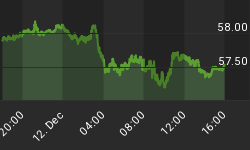I have spent many an hour in the last couple of weeks looking at gold prices, the dollar, and gold mining stocks trying to figure out if gold was headed higher or if it was going to be the dollar. Back and forth prices went for 5 months with no clear trend. This uncertainty is also reflected in the charts as price has virtually ground to a halt. But if there is one thing that is certain about the markets (and may be the only thing), a consolidation in prices is generally followed by a breakout from that consolidation.
And I believe we are on the verge of a breakout from this period, and The Winner Is......
GOLD.
Yet the other day didn't I state that inflation was tame, and we should expect interest rates to fall after a pullback from their lows. We all know that when there is inflation, gold and interest rates go up? Right? Then this isn't the environment for higher gold prices!? Well that is the dogma. Isn't it? But the data over the past 30 years suggests otherwise.
Interest Rates and Gold
Let's ask the following question: what happens to the price of gold if interest rates are lower today than 6 months ago? I have designed such a system and the results are shown in Table 1. The opposite, higher interest rate scenario is shown in the adjacent column. From this data it is clear that gold does a lot better when interest rates are falling. A lot better.
Table 1.
So why is that? I guess the old adage that "Gold is a hedge against inflation" is true. The time to buy gold is not when there is inflation but when there is reflation. By the time we read about inflation and higher interest rates in the newspapers well it is just too late. Inflation isn't here yet....I guess that is why gold is called a "hedge".
By reflation, I mean the inflationary monetary policies of the Federal Reserve Board. But didn't the Fed raise rates today? Yes they did. But the bond market is signaling that the economy isn't so good, thus rates have been going lower. So it is my guess that the Fed has raised rates but only to give itself room to operate should the economy slow further or if there is a shock to the system.
So what about the late 1970's and the early 1980's when yields on the long bond were routinely above 10% and when gold shot into the stratosphere? Well this is true: yields did go up and so did gold. But this is also true: from a trading perspective and over the last 30 years this represented the once in a life time event. It is hard to make money from a once in a life time event! Will it happen again? Maybe. But the numbers say that as yields fall, gold should rise.
Look at the relative strength indicator (figure 1, panel 2) in the daily price chart that compares the Philadelphia Silver and Gold Mining Index ($XAU.X) to the yield on the 30 year Treasury bond. You can see the dynamic that has been at work for the past 18 months. Yields go down or sideways and the gold index goes up.
Figure 1. $XAU.X v. 30 yr. Treasury/ daily
For a longer term perspective refer to figure 2, which is a weekly chart of the $XAU.X and the 30 year Treasury bond. The indicator is a relative strength line, and what is interesting is the behavior of gold and silver mining shares once the trend line was "recaptured". By "recaptured" I mean the long term trend line (drawn on the relative strength indicator) that initially lent support to prices was broken (red down arrows), and at a later date, it was penetrated or "recaptured" to the upside (blue up arrows) eventually leading to much higher prices.
How low can interest rates go? From the weekly chart of the 30 year Treasury bond shown in figure 3, yields will find support around 4.7%; support beyond that is at 4.2%.

Figure 3. 30 yr. Treasury/ weekly
What about the dollar? The dollar appears to be headed lower. Look at figure 4 (next page). Gold is in the top panel and the dollar is in the second panel. I have applied the Price Structure Analysis" indicator to both price charts. You can see that gold is bullish and the dollar is bearish. Furthermore, I have drawn trend lines on the indicator showing that gold has cleared 2 down trend lines and the dollar has fallen below 2 up trend lines. This clearly is bullish action for gold and bearish action for the dollar.
Figure 4. Gold v. Dollar/ weekly
And that is The Technical Take!
I hope you have found my commentary insightful and profitable.
















